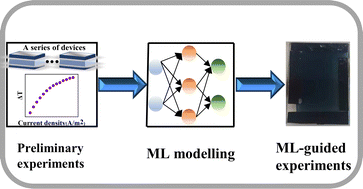Machine learning-guided investigation for a high-performance electrochromic device based on ammonium metatungstate-iron(ii) chloride-heavy water electrochromic liquid†
Abstract
Electrochromic devices have been widely studied due to their ability to change transmittance under the application of electrical current. However, there is still a lack of an effective tool to guide the development of high-performance electrochromic devices. Here, we design a high-performance electrochromic device, which is composed of a mixed functional layer synthesized from ammonium metatungstate and iron(II) chloride in a heavy water solvent, with the aid of a multilayer perceptron (MLP) model. We first prepare 25 devices with different concentrations of ammonium metatungstate and iron(II) chloride, and use their transmittance modulation amplitude (ΔT) current density data to train an MLP model. Then, this model is further used to guide the experimental fabrication of the best-performing device. The fabricated device exhibits high ΔT (74%), rapid response time (tc = 6.5 s and tb = 13.5 s), and long cycling life (>1000), which represents a breakthrough in the field of inorganic all-liquid electrochromic devices. Our study showcases a new paradigm of developing high-performance electrochromic devices by using machine learning.



 Please wait while we load your content...
Please wait while we load your content...